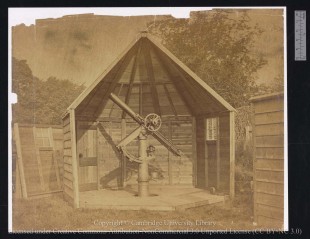…where east meets west
- Home
- Brief History
- The Greenwich Meridian
- Greenwich
(1675–1958) - Herstmonceux
(1948–1990) - Cambridge
(1990–1998) - Outstations (1822–1971)…
- – Chingford (1822–1924)
- – Deal
(1864–1927) - – Abinger
(1923–1957) - – Bristol & Bradford on Avon
(1939–1948) - – Bath
(1939–1949) - – Hartland
(1955–1967) - – Cape of Good Hope
(1959–1971)
- Administration…
- – Funding
- – Governance
- – Inventories
- – Pay
- – Regulations
- – Royal Warrants
- Contemporary Accounts
- People
- Publications
- Science
- Technology
- Telescopes
- Chronometers
- Clocks & Time
- Board of Longitude
- Libraries & Archives
- Visit
- Search
Telescope: Naylor Equatorial (1863)

Taken in 1872 or1873, this photograph shows what is believed to be the Naylor Equatorial undergoing testing at Greenwich following the modifications that had been made to the mounting. The hut, which has still to have its identifying markings stencilled onto each of its component parts has had the front panels temporarily removed so that the telescope could be seen inside. Reproduced under the terms of a Creative Commons Attribution-Non-Commercial (CC BY-NC) licence courtesy of Cambridge Digital Library (see below)
Made by Messrs. T. Cooke and Sons, of York, it had an object-glass of 6-inches clear aperture and 89-inches focal length and was inscribed with the date 1863. It was not however completely finished before 1866.
The British set up five Stations across the globe from which to observe the Transit. Before any instruments were shipped, they were set up in their observing huts at Greenwich for testing. The Naylor Equatorial required considerable adaption of its mounting in order for it to be used at a significantly different latitude (RGO6/278/128). It was one of the instruments sent to the Sandwich Islands (Station B), where observing posts were established on three of the islands: Honolulu (Oahu), Jailua (Hawaii) and Wimea (Kauai). The Naylor was used at Honolulu.
Together with many of the other Transit of Venus instruments, the Naylor appears to have been formally transferred to the Royal Observatory in 1876. Included, were all the 6-inch equatorials. Of the six, the Lee and the Hodgson were on English mountings, whilst the other four were all on German ones. Of these, the Corbett was supported on a tripod rather than an iron pillar like the Naylor and the two equatorials by Simms (Simms No.1 and Simms No.2). The Naylor appears to have been the superior instrument. In 1880, it was set up under a suitable protective covering in the South Ground for the occasional observation of comets, Jupiter’s satellites, eclipses etc. In 1881/2 it was moved to a more convienient position in the lower part of the South Ground at a greater distance from the dip instrument.
Lost at Sea
In 1882 the Naylor was sent on the Transit of Venus expedition to Bermuda where it was used by Lieut. C.B. Neate, R.N. On the way back, it was lost at sea when the passenger liner City of Brussels on which it was being carried sank on 7 January 1883 following a collision at the mouth of the River Mersey. In 1884, the Observatory was given one of the two 6-inch equatorials by Cooke that were purchased new for the 1882 Transit. Known as Cooke No.1 and Cooke Number 2, it was the second of these that was given to the Observatory.
Images
The only known fully authenticated images of the Naylor are drawings. One is held in the Observatory archives in Cambridge (RGO6/278/131) and was drawn in 1869 by Edwin Dunkin who went to examine the telescope for Airy prior to its purchase and modification. Key dimensions are marked. They include: the length of the tube (8 feet), the height of the cast iron pier (6 feet 9 inches) and the width of the pier. This is shown as being circular in section and marked as being 9 inches in diameter from its top to its middle, widening to 26 inches at the base. The others are a number of caricature drawings by Lieutenant Evelyn James Wheelock Noble who was one of the party that went to observe the transit in Honolulu. They are preserved in The Life and Adventures of Station B, Album 1, which has recently (2016) been digitised by Cambridge Universtiy Library. The following links are to two of the clearest: Click here for the first image 1 and click here for the second.
Confusingly, the only known set of images of a Transit of Venus equatorial hut earmarked to be sent to Station B (Sandwich Islands) that was photographed at Greenwich, all show it housing what is understood to be one of the two Simms Equatorials which were sent to Stations C and D.
Contemporary accounts and some of the published observations
Account of observations of the Transit of Venus, 1874, December 8, made under the authority of the British government: and of the reduction of the observations. Edited by Sir George Biddell Airy, (HMSO, 1881)
Observations of occultations of stars by the Moon, of phenomena of Jupiter’s satellites, and of the eclipse of the Sun, December 31, 1880, Royal Observatory, Greenwich. MNRAS, Vol. 41, pp.122–131
Observations of Comet a, 1882. MNRAS Vol. 43, p.26
Image Licensing
The image of the Naylor Equatorial in the Transit of Venus hut at Greenwich is reproduced in compressed form under the terms of a Creative Commons Attribution-NonCommercial 3.0 Unported License courtesy of Cambridge Digital Library (RGO6/276).
© 2014 – 2025 Graham Dolan
Except where indicated, all text and images are the copyright of Graham Dolan